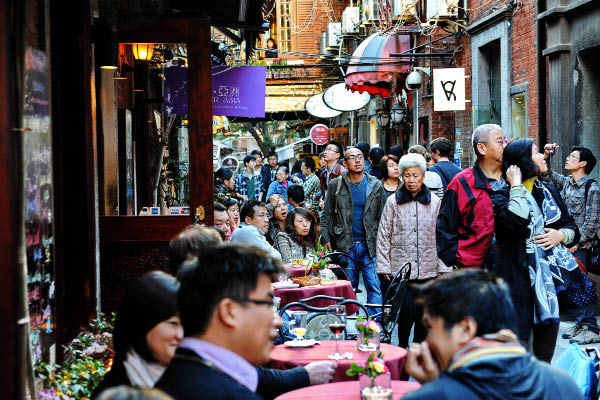Shanghai Reminiscences
Located at the confluence of three rivers, Xujiahui was where Ming Dynasty scientist and Shanghai native Xu Guangqi (1562-1633) lived on his farm, hence its name. Xu, in collaboration with Italian Jesuit missionary Matteo Ricci (1552-1610), translated six volumes of Euclid’s Elements, and compiled the Complete Treatise on Agriculture (Nongzheng Quanshu), one of China’s four greatest ancient agricultural books.
After getting my free ticket at the district’s tourist center, I headed for the Xujiahui Library, founded by the Jesuits in 1847. Its collection of rare publications in Chinese and foreign languages was transferred to the municipal library in 1956. Those remaining are mostly foreign-language books and periodicals published before the founding of the PRC.
The first floor was for Chinese books. Its interior design replicates that of the 450-year-old Tianyige private library in Ningbo, Zhejiang Province. The second floor is for foreign-language titles – totally 80,00-strong published between the 15th century and 1949. The layout pays clear tribute to the Vatican Library. The most treasured of its collection are those on Sinology and theology.
Other than reading rooms for cardholders, the building is not open to the public. As a journalist I was privileged to visit it. When I entered what was formerly the dining space, only a couple of readers were there, poring over foreign-language newspapers and magazines. The soft, warm lighting and scent of ink on sepia-toned pages conjured up a soothing nostalgia that was in sharp contrast to the bustle of traffic outside.
 |
| Tianzifang, a former rundown lane area, is now a cultural hub of the city. |
The Xujiahui Cathedral, or St. Ignatius Cathedral, is walking distance from the library. Designed by English architect W. M. Dowdall and built between 1905 and 1910, the stately twin-spire Gothic building was the largest church in the Far East of its time, accommodating up to 3,000 worshipers.
The last leg of my Xujiahui tour was the Tou-Se-We Museum, formerly a Jesuit orphanage for boys. To ensure they would be financially independent in adulthood, the facility ran classes in practical skills such as painting, sculpture, woodwork and printing. It also owned arts and crafts workshops that hired boys when they were old enough to leave the orphanage. Their products were popular, and received orders from abroad as well as throughout the country. One of its works, a 1913 wood carving of an archway, appeared in three World Expos. It is now on display at the museum.
Architecture is like frozen music. In Shanghai it is also arrested history – a standing monument to the Shanghai-style culture that embodies a merging of Eastern and Western civilizations. Evident in local buildings, the educational system, places of worship and film-making locales, Xujiahui’s historic sites offer a rare glimpse of the city’s early existence.
Back Lanes
Tower blocks dominate the Shanghai skyline. But old paths that retain traces of the past century still exist in this monument to contemporary international commerce.
One is Wukang Road in Xuhui District, originally named Route Ferguson, built in 1907 by the French Concession authority. Several famed historical personages owned properties along this densely shaded road. They include Qing reformist official Li Hongzhang (1823-1901), revolutionist Huang Xing (1874-1916) and writer Ba Jin (1904-2005).
The tourist service center at 393 Jia Wukang Road offers visitors travel guides to the scale models and photo exhibitions of past celebrities’ residences in the region. The center holds lectures on the first Saturday of each month on local history, themed “Stories of Old Homes.”
Wukang is also a popular bar area. A favorite expat hang-out, local hostelries open in the afternoon and are heaving by nightfall.
Shaoxing Road is also part of the bygone French Concession. The 300-meter-long path is lined with stately oriental plane trees that overlook the dense cluster of bookstores and galleries below as well as the Shanghai Press and Publication Administration, Shanghai Art and Literature Press and Shanghai Business Daily offices. Some of the best-preserved Shikumen buildings, an architectural genre of the late 19th century combining classic southern China style with European elements, are also found on Shaoxing Road.
Having escaped industrialization, the region is a popular shooting site for productions about old Shanghai. It is the backdrop of many movies and TV dramas.
Xintiandi, a 30,000-square-meter pedestrian commercial district in central Shanghai, also features a number of Shikumen residences. Its old lane residences having been converted into shops, cafes, restaurants and entertainment centers, the area juxtaposes the best of old and new Shanghai.
The rhythm of urban life is hectic everywhere, but the Shanghai ambience remains laid-back and easy. Visitors and residents alike enjoy leisurely strolls down time-honored lanes that clearly echo the vibrant memories of this century-old city.

